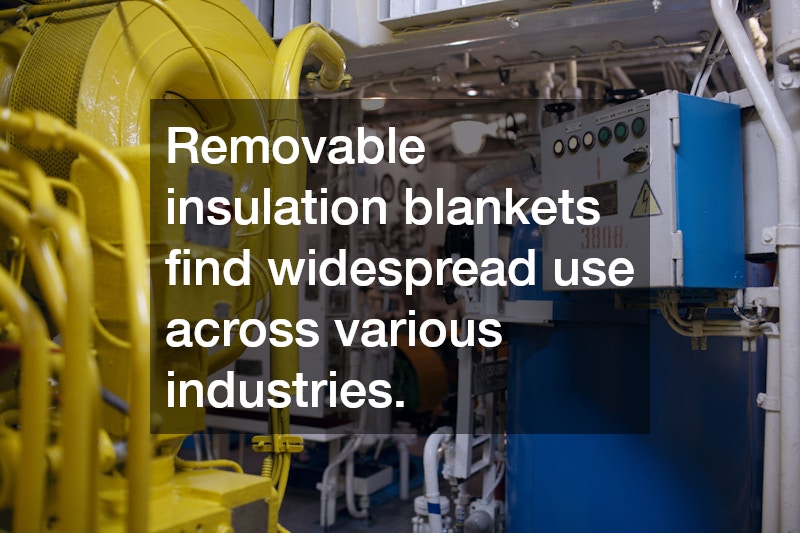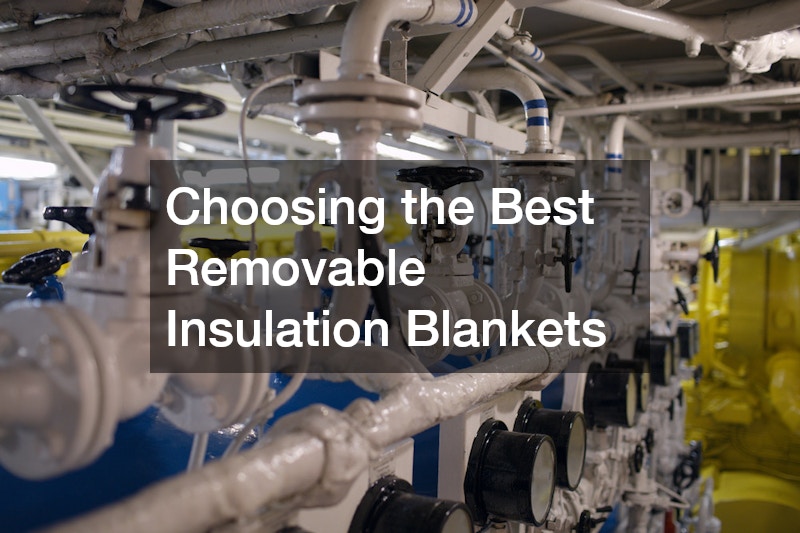In this article, we explore the essential aspects of selecting the best removable insulation blankets. These versatile and efficient solutions are key to energy conservation, reducing operational costs, and improving safety in industrial settings.
What are Removable Insulation Blankets and Why Use Them?
Removable insulation blankets are flexible and reusable insulation solutions that provide several benefits in industrial environments. Their ease of installation allows for quick deployment and repositioning, making them ideal for scenarios where frequent access to equipment is necessary.
Additionally, they enhance energy efficiency by reducing heat loss, which in turn lowers energy costs and contributes to more sustainable operations.
These blankets also help mitigate noise pollution, providing a quieter work environment and improving worker safety and comfort. By offering robust protection against extreme temperatures, they minimize the risk of burns or other thermal injuries, ensuring safe operation and maintenance of industrial equipment. In industries where high temperatures are prevalent, such as petrochemical or power generation facilities, the importance of reliable insulation cannot be overstated.
The adaptability of removable insulation blankets makes them suitable for a wide range of applications, benefiting sectors from manufacturing to chemical processing. Their utility is especially prominent in environments that require regular maintenance and inspection, as the blankets can be removed and reapplied without difficulty. Versatility, efficiency, and safety make removable insulation blankets an excellent choice for industrial insulation needs.
How to Choose the Right Material for Insulation Blankets?
The choice of materials for removable insulation blankets is critical, as it affects their performance and suitability for specific applications. Fiberglass is a popular choice due to its excellent thermal insulation properties and cost-effectiveness. It withstands moderate temperature ranges, making it suitable for a variety of industrial uses.
Silica-based insulation is another option, known for its low thermal conductivity and high temperature resistance, up to 1800°F (982°C). This makes silica a preferred choice for high-temperature environments, offering durability and effective insulation. On the other hand, ceramic fiber provides superior performance at even higher temperatures, often exceeding 2300°F (1260°C), but at a higher cost.
Each material offers distinct advantages, and the decision should be based on the specific operational temperature requirements, environmental conditions, and budget constraints. For instance, high-temperature operations may necessitate the use of advanced materials like ceramic fibers, despite the associated costs, to ensure safety and efficiency.
What Are the Key Features to Look For in a Removable Insulation Blanket?
When selecting an insulation blanket, thermal conductivity is a key specification that determines its effectiveness in minimizing heat transfer. The lower the thermal conductivity, the better the material insulates against heat loss, leading to enhanced energy efficiency. Concurrently, the operating temperature range of the insulation material is crucial, as it must align with the temperatures encountered in specific applications.
Durability is another critical factor, as the insulation blankets are often subject to harsh conditions and frequent handling. The robustness of the material ensures a long lifespan and consistent performance over time. Materials that resist wear, moisture, and chemical exposure can significantly extend the operational life of insulation blankets.
Ease of maintenance and installation are also important considerations, as these factors influence the practical deployment and ongoing usability of the product. Insulation blankets that are simple to install and maintain minimize downtime and reduce labor costs, thus improving overall efficiency in industrial settings.
What Are the Common Applications for Removable Insulation Blankets?
Removable insulation blankets find widespread use across various industries due to their adaptability and efficiency. In petrochemical plants, they are essential for insulating pipes and machinery that handle high-temperature processes, significantly reducing energy expenditures and safeguarding personnel. In power generation facilities, insulation blankets play a key role in the management of steam systems and turbines, where precise temperature regulation is crucial for efficient operation.
The chemical processing industry also benefits from these blankets, utilizing them to insulate reactors and vessels where precise temperature control is vital for product quality and process efficiency. Beyond these sectors, wastewater treatment plants and food processing facilities use insulation blankets to maintain desired temperature levels, enhancing process reliability and energy conservation.
The practical applications of removable insulation blankets extend to any environment where temperature regulation and energy efficiency are priorities. Their easy removability allows for efficient maintenance operations, making them indispensable in industries where equipment accessibility and worker safety are paramount.
Choosing the best removable insulation blankets involves understanding the material options, features, and their applications. By considering these factors and implementing proper installation and maintenance practices, businesses can achieve significant energy savings, safety improvements, and operational efficiencies. The integration of removable insulation blankets into industrial processes underscores their value as a cost-effective and adaptable thermal management solution.
.
In this article, we explore the essential aspects of selecting the best removable insulation blankets. These versatile and efficient solutions are key to energy conservation, reducing operational costs, and improving safety in industrial settings.
What are Removable Insulation Blankets and Why Use Them?
Removable insulation blankets are flexible and reusable insulation solutions that provide several benefits in industrial environments. Their ease of installation allows for quick deployment and repositioning, making them ideal for scenarios where frequent access to equipment is necessary.
Additionally, they enhance energy efficiency by reducing heat loss, which in turn lowers energy costs and contributes to more sustainable operations.
These blankets also help mitigate noise pollution, providing a quieter work environment and improving worker safety and comfort. By offering robust protection against extreme temperatures, they minimize the risk of burns or other thermal injuries, ensuring safe operation and maintenance of industrial equipment. In industries where high temperatures are prevalent, such as petrochemical or power generation facilities, the importance of reliable insulation cannot be overstated.
The adaptability of removable insulation blankets makes them suitable for a wide range of applications, benefiting sectors from manufacturing to chemical processing. Their utility is especially prominent in environments that require regular maintenance and inspection, as the blankets can be removed and reapplied without difficulty. Versatility, efficiency, and safety make removable insulation blankets an excellent choice for industrial insulation needs.
How to Choose the Right Material for Insulation Blankets?
The choice of materials for removable insulation blankets is critical, as it affects their performance and suitability for specific applications. Fiberglass is a popular choice due to its excellent thermal insulation properties and cost-effectiveness. It withstands moderate temperature ranges, making it suitable for a variety of industrial uses.
Silica-based insulation is another option, known for its low thermal conductivity and high temperature resistance, up to 1800°F (982°C). This makes silica a preferred choice for high-temperature environments, offering durability and effective insulation. On the other hand, ceramic fiber provides superior performance at even higher temperatures, often exceeding 2300°F (1260°C), but at a higher cost.
Each material offers distinct advantages, and the decision should be based on the specific operational temperature requirements, environmental conditions, and budget constraints. For instance, high-temperature operations may necessitate the use of advanced materials like ceramic fibers, despite the associated costs, to ensure safety and efficiency.
What Are the Key Features to Look For in a Removable Insulation Blanket?
When selecting an insulation blanket, thermal conductivity is a key specification that determines its effectiveness in minimizing heat transfer. The lower the thermal conductivity, the better the material insulates against heat loss, leading to enhanced energy efficiency. Concurrently, the operating temperature range of the insulation material is crucial, as it must align with the temperatures encountered in specific applications.
Durability is another critical factor, as the insulation blankets are often subject to harsh conditions and frequent handling. The robustness of the material ensures a long lifespan and consistent performance over time. Materials that resist wear, moisture, and chemical exposure can significantly extend the operational life of insulation blankets.
Ease of maintenance and installation are also important considerations, as these factors influence the practical deployment and ongoing usability of the product. Insulation blankets that are simple to install and maintain minimize downtime and reduce labor costs, thus improving overall efficiency in industrial settings.
What Are the Common Applications for Removable Insulation Blankets?
Removable insulation blankets find widespread use across various industries due to their adaptability and efficiency. In petrochemical plants, they are essential for insulating pipes and machinery that handle high-temperature processes, significantly reducing energy expenditures and safeguarding personnel. In power generation facilities, insulation blankets play a key role in the management of steam systems and turbines, where precise temperature regulation is crucial for efficient operation.
The chemical processing industry also benefits from these blankets, utilizing them to insulate reactors and vessels where precise temperature control is vital for product quality and process efficiency. Beyond these sectors, wastewater treatment plants and food processing facilities use insulation blankets to maintain desired temperature levels, enhancing process reliability and energy conservation.
The practical applications of removable insulation blankets extend to any environment where temperature regulation and energy efficiency are priorities. Their easy removability allows for efficient maintenance operations, making them indispensable in industries where equipment accessibility and worker safety are paramount.
Choosing the best removable insulation blankets involves understanding the material options, features, and their applications. By considering these factors and implementing proper installation and maintenance practices, businesses can achieve significant energy savings, safety improvements, and operational efficiencies. The integration of removable insulation blankets into industrial processes underscores their value as a cost-effective and adaptable thermal management solution.
.




